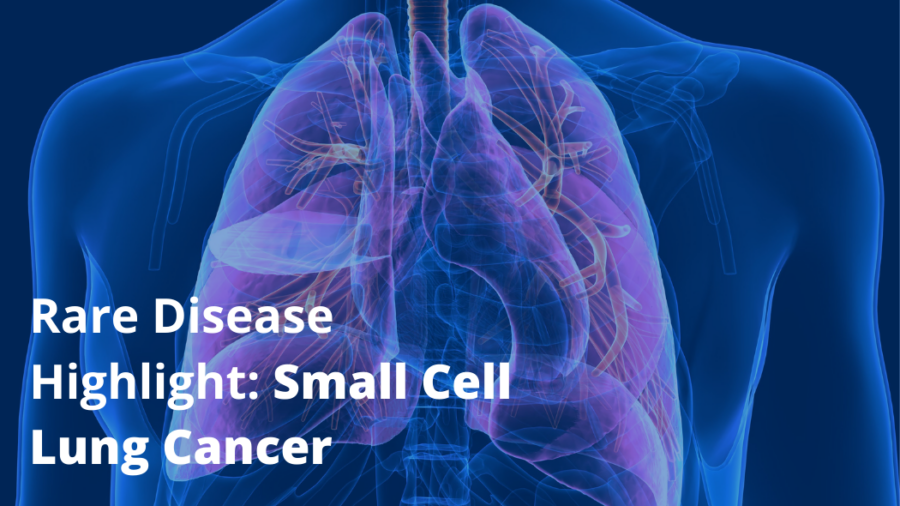Small cell lung cancer (SCLC) is an aggressive form of lung cancer primarily associated with a history of cigarette smoking (Rudin et al., 2021). SCLC is a highly metastatic cancer, meaning it spreads from site of origin (the lungs) to other parts of the body. Approximately 70% of patients present with advance disease showing macro metastases in either the brain, liver, bones, or lymph nodes at initial diagnosis (Ko et al., 2021). The highly aggressive nature of SCLC leads to significant morbidities and 1-year survival rates of only 32.9%. Survival continues to drop, with only 10.7% of patients surviving 3 years after diagnosis (SEER, 2022). SCLC is a rare disease that affects approximately 30,000 people in the US (SEER, 2018, 2022).
SCLC has been directly linked to carcinogens associated with tobacco products (Saltos et al., 2020). Smoking is believed to be the cause of 98% of SCLC cases, whether it be in active smokers, or people with a prior history of smoking. The remaining 2% of cases, known as never-smokers, may be linked to air pollution but data is still limited. Regardless of a patient’s smoking status, SCLC is initiated by the concomitant inactivation of the genes TP53 and RB1. These genes encode the tumor suppressor proteins p53 and retinoblastoma (RB), both of which have important effects in the life cycle of human cells and control of tumor progression. RB inhibits entry to the S phase of the cell cycle, the period of the cell cycle during which DNA is replicated, and thus blocks cell division. The p53 protein is an important regulator of cell cycle arrest and cellular death (known as apoptosis) as a response to genetic aberrations (Rudin et al., 2021). The inactivation of these proteins leads to unregulated proliferation of aberrant and cancerous pulmonary neuroendocrine cells (specialized airway epithelial cells), ultimately causing SCLC (George et al., 2015, Noguchi et al., 2020).
The current standard of care (SoC) for SCLC patients is either chemoradiation therapy or combination chemotherapy. SCLC is typically very responsive to either option initially, with response rates as high as 70% (Rudin et al., 2021; Wang et al., 2019). Unfortunately, this initial response is short-lived and SCLC inevitably becomes resistant to chemotherapeutic agents (Wang et al., 2019). The only available second line therapy is the chemotherapeutic agent, topotecan (Hycamtin), with low response rates between 6-17% and median survival time of only 26 weeks after treatment initiation (Hiddinga et al., 2021). Although it has not become SoC, surgical resection is an option for patients with stage I disease. However, only 4% of patients present with solitary tumor and the currently available studies on resection have not provided clear evidence of any long-term benefit (Hiddinga et al., 2021; Wang et al., 2019). The high mortality rates along with the general lack of response durability and alternative treatment options for patients with SCLC highlights a significant unmet medical need in this patient population.
References
- George, J., Lim, J. S., Jang, S. J., Cun, Y., Ozretić, L., Kong, G., . . . Thomas, R. K. (2015). Comprehensive genomic profiles of small cell lung cancer. Nature, 524(7563), 47-53. doi:10.1038/nature14664
- Hiddinga, B. I., Raskin, J., Janssens, A., Pauwels, P., & Van Meerbeeck, J. P. (2021). Recent developments in the treatment of small cell lung cancer. European Respiratory Review, 30(161), 210079. doi:10.1183/16000617.0079-2021
- Ko, J., Winslow, M. M., & Sage, J. (2021). Mechanisms of small cell lung cancer metastasis. EMBO Mol Med, 13(1), e13122. doi:10.15252/emmm.202013122
- Noguchi, M., Furukawa, K. T., & Morimoto, M. (2020). Pulmonary neuroendocrine cells: physiology, tissue homeostasis and disease. Dis Model Mech, 13(12). doi:10.1242/dmm.046920
- Rudin, C. M., Brambilla, E., Faivre-Finn, C., & Sage, J. (2021). Small-cell lung cancer. Nat Rev Dis Primers, 7(1), 3. doi:10.1038/s41572-020-00235-0
- Saltos, A., Shafique, M., & Chiappori, A. (2020). Update on the Biology, Management, and Treatment of Small Cell Lung Cancer (SCLC). Front Oncol, 10, 1074. doi:10.3389/fonc.2020.01074
- SEER. (2018). Small cell carcinoma of the Lung and Bronchus
- People Alive with Cancer (U.S. Prevalence) on January 1, 2018. Retrieved from https://seer.cancer.gov/explorer/application.html?site=611&data_type=5&graph_type=12&compareBy=sex&chk_sex_1=1&series=9&race=1&age_range=1&prev_duration=1&advopt_limprev_y_axis_var=0#tableWrap
- SEER. (2022). Small cell carcinoma of the Lung and Bronchus. Surveillance Epidemiology and End Results Retrieved from https://seer.cancer.gov/explorer/application.html?site=611&data_type=1&graph_type=2&compareBy=sex&chk_sex_1=1&hdn_rate_type=1&race=1&age_range=1&stage=101&advopt_precision=1&advopt_show_ci=on&advopt_display=2#tableWrap
- Wang, S., Zimmermann, S., Parikh, K., Mansfield, A. S., & Adjei, A. A. (2019). Current Diagnosis and Management of Small-Cell Lung Cancer. Mayo Clinic Proceedings, 94(8), 1599-1622. doi:https://doi.org/10.1016/j.mayocp.2019.01.034
BioPharma Global is a mission-driven corporation dedicated to using our FDA and EMA regulatory expertise and knowledge of various therapeutic areas to help drug developers advance treatments for the disease communities with a unmet medical needs. If you are a drug developer seeking regulatory support for Orphan Drug designation, Fast Track designation, Breakthrough Therapy designation, other FDA/EMA expedited programs, type A, B (pre-IND, EOPs), or C meeting assistance, or IND filings, the BioPharma Global team can help. Contact us today to arrange a 30-minute introductory call.

